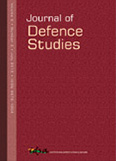The Geopolitics of Cyber Espionage
There is an intricate relationship between the methods of cyber espionage and the evolution of information and communications technology, of which information security is a key aspect. This article is an attempt to establish forward and backward linkages of cyber espionage. It examines the geopolitics, methods, role of information security technology and, most importantly, how the future of cyber espionage is being shaped by emerging technologies such as supercomputing, quantum computing and ‘big data’, from an Indian perspective.
- Munish Sharma |
- January 2015 |
- Journal of Defence Studies





